Ground Cover Rice Production System Affects Soil Water, Nitrogen Dynamics and Crop Growth Differentially with or without Climate Stress
Abstract
:1. Introduction
2. Results
2.1. Effect of Ground Cover Rice Production System on the Dynamics of Soil Water Storage
2.2. Effect of Ground Cover Rice Production System on the Dynamics of Soil Mineral N
2.3. Effect of Ground Cover Rice Production System on Crop Growth
2.3.1. Plant Height Dynamics
2.3.2. Tiller Dynamics
2.3.3. Leaf Area Index Dynamics
2.3.4. Aboveground Dry Matter Dynamics
2.3.5. Crop Yield
2.4. Direct and Indirect Effects of Ground Cover Rice Production System on Soil Water and N Dynamics and Crop Growth
3. Discussion
3.1. Effects of Ground Cover Rice Production System on Soil Water and N Dynamics
3.2. Effects of Ground Cover Rice Production System on Crop Yield and Biological Indicators
3.3. Driving Factors of Crop Yield under Ground Cover Rice Production System
4. Materials and Methods
4.1. Site Description
4.2. Experimental Design and Field Management
4.3. Observations and Measurement Methods
4.4. Statistical Analysis
5. Conclusions
Author Contributions
Funding
Data Availability Statement
Conflicts of Interest
References
- FAO. Available online: http://www.fao.org/faostat/en/#data (accessed on 10 December 2022).
- Hussain, T.; Mulla, D.; Hussain, N.; Qin, R.J.; Tahir, M.; Liu, K.; Harrison, M.T.; Sinutok, S.; Duangpan, S. Optimizing nitrogen fertilization to enhance productivity and profitability of upland rice using CSM–CERES–Rice. Plants 2023, 12, 3685. [Google Scholar] [CrossRef]
- Qiu, H.N.; Yang, S.H.; Jiang, Z.W.; Xu, Y.; Jiao, X.Y. Effect of Irrigation and fertilizer management on rice yield and nitrogen loss: A meta-analysis. Plants 2022, 11, 1690. [Google Scholar] [CrossRef] [PubMed]
- Spanu, A.; Langasco, I.; Barracu, F.; Deroma, M.A.; López-Sánchez, J.F.; Mara, A.; Meloni, P.; Pilo, M.I.; Estrugo, A.S.; Spano, N.; et al. Influence of irrigation methods on arsenic speciation in rice grain. J. Environ. Manag. 2022, 321, 115984. [Google Scholar] [CrossRef] [PubMed]
- Xiong, Y.J.; Peng, S.Z.; Luo, Y.F.; Xu, J.Z.; Yang, S.H. A paddy eco-ditch and wetland system to reduce non-point source pollution from rice-based production system while maintaining water use efficiency. Environ. Sci. Pollut. Res. 2015, 22, 4406–4417. [Google Scholar] [CrossRef] [PubMed]
- Kang, S.Z.; Zhang, L.; Trout, T. Special issue: Improving agricultural water productivity to ensure food security under changing environments. Agric. Water Manag. 2017, 179, 1–4. [Google Scholar] [CrossRef]
- Huang, J.D.; Cao, X.Y.; Kuai, J.; Cheng, H.; Zuo, Q.S.; Du, H.; Peng, S.B.; Huang, J.L.; Deng, N.Y. Evaluation of production capacity for rice-rapeseed cropping system in China. Field Crops Res. 2023, 293, 108842. [Google Scholar] [CrossRef]
- Jiang, P.; Xu, F.X.; Zhang, L.; Liu, M.; Xiong, H.; Guo, X.Y.; Zhu, Y.C.; Zhou, X.B. Impact of tillage and crop establishment methods on rice yields in a rice-ratoon rice cropping system in Southwest China. Sci. Rep. 2021, 11, 18421. [Google Scholar] [CrossRef]
- Zhang, F.L.; Wang, R.J.; Zhang, H.D.; He, Z.W.; Zhang, J.C. Analysis on the reasons for super high yield of rice in southwest Guizhou region. China Rice 2023, 29, 114–118. [Google Scholar] [CrossRef]
- Dong, Y.J.; Zeng, F.W.; Yuan, J.; Zhang, G.B.; Chen, Y.X.; Lui, X.J.; Hilario, P.; Ren, T.S.; Lu, S.H. Integrated rice management simultaneously improves rice yield and nitrogen use efficiency in various paddy fields. Pedosphere 2020, 30, 863–873. [Google Scholar] [CrossRef]
- Chen, X.X.; Wang, L.C.; Niu, Z.G.; Zhang, M.; Li, C.A.; Li, J.R. The effects of projected climate change and extreme climate on maize and rice in the Yangtze River Basin, China. Agric. For. Meteorol. 2020, 282, 107867. [Google Scholar] [CrossRef]
- Jiang, H.; Xing, X.; Meng, X.; Chen, J.L.; Yu, K.; Xu, X.T.; Zhang, R.; Wei, Z.H.; Wang, D.C.; Cang, B.F.; et al. Research progress in water-saving cultivation of rice in China. Crop Sci. 2023, 63, 2623–2635. [Google Scholar] [CrossRef]
- Guo, L.; Liu, M.J.; Zhang, Y.A.; Tao, Y.Y.; Zhang, F.; Li, G.Y.; Dittert, K.; Lin, S. Yield differences get large with ascendant altitude between traditional paddy and water-saving ground cover rice production system. Eur. J. Agron. 2018, 92, 9–16. [Google Scholar] [CrossRef]
- Chen, J.; Li, S.Q.; Li, C.; Wang, H.; Geng, Y.J.; Kong, D.L.; Liu, S.W.; Zou, J.W. Post-seasonal effects of water-saving rice production regimes on N2O emissions in an annual rice-barley rotation system. Catena 2019, 182, 104112. [Google Scholar] [CrossRef]
- Hsiao, T.C. Effects of Drought and Elevated CO2 on Plant Water Use Efficiency and Productivity; Spinger: Berlin, Germany, 1993; pp. 435–465. [Google Scholar]
- Chen, J.; Li, C.; Kong, D.L.; Geng, Y.J.; Wang, H.; Fang, X.T.; Li, S.Q.; Hu, Z.Q.; Liu, S.W.; Zou, J.W. Incorporating DNA-level microbial constraints helps decipher methane emissions from Chinese water-saving ground cover rice production systems. Field Crops Res. 2021, 260, 107992. [Google Scholar] [CrossRef]
- Sudhir, Y.; Humphreys, E.; Kukal, S.S.; Gill, G.; Rangarajan, R. Effect of water management on dry seeded and puddled transplanted rice. Part 2: Water balance and water productivity. Field Crops Res. 2011, 120, 123–132. [Google Scholar] [CrossRef]
- Tao, Y.Y.; Zhang, Y.N.; Jin, X.X.; Saiz, G.; Jing, R.Y.; Guo, L.; Liu, M.J.; Shi, J.C.; Zuo, Q.; Tao, H.B.; et al. More rice with less water–evaluation of yield and resource use efficiency in ground cover rice production system with transplanting. Eur. J. Agron. 2015, 68, 13–21. [Google Scholar] [CrossRef]
- Jin, X.X.; Zuo, Q.; Ma, W.W.; Li, S.; Shi, J.C.; Tao, Y.Y.; Zhang, Y.A.; Liu, Y.; Liu, X.F.; Lin, S.; et al. Water consumption and water-saving characteristics of a ground cover rice production system. J. Hydrol. 2016, 540, 220–231. [Google Scholar] [CrossRef]
- Liu, M.J.; Liang, W.L.; Qu, H.; Zhi, G.Y.; Chen, Q.X.; Gong, Y.S.; Butterbach-Bahl, K.; Lin, S. Ground cover rice production systems are more adaptable in cold regions with high content of soil organic matter. Field Crops Res. 2014, 164, 74–81. [Google Scholar] [CrossRef]
- Vial, L.K.; Lefroy, R.D.B.; Fukai, S. Application of mulch under reduced water input to increase yield and water productivity of sweet corn in a lowland rice system. Field Crops Res. 2015, 171, 120–129. [Google Scholar] [CrossRef]
- Fawibe, O.; Honda, K.; Taguchi, Y.; Park, S.; Isoda, A. Greenhouse gas emissions from rice field cultivation with drip irrigation and plastic film mulch. Nutr. Cycl. Agroecosyst. 2019, 133, 51–62. [Google Scholar] [CrossRef]
- Gao, Y.J.; Li, Y.; Zhang, J.C.; Liu, W.G.; Dang, Z.P.; Cao, W.X.; Qiang, Q. Effects of mulch N fertilizer and plant density on wheat yield wheat nitrogen uptake and residual soil nitrate in a dryland area of China. Nutr. Cycl. Agroecosyst. 2009, 85, 109–121. [Google Scholar] [CrossRef]
- Yao, Z.; Du, Y.; Tao, Y.; Zheng, X.; Liu, C.; Lin, S.; Butterbach-Bahl, K. Water-saving ground cover rice production system reduces net greenhouse gas fluxes in an annual rice-based cropping system. Biogeosciences 2014, 11, 6221–6236. [Google Scholar] [CrossRef]
- Liang, H.; Hu, K.L.; Qin, W.; Zuo, Q.; Guo, L.; Tao, Y.Y.; Lin, S. Ground cover rice production system reduces water consumption and nitrogen loss and increases water and nitrogen use efficiencies. Field Crops Res. 2019, 233, 70–79. [Google Scholar] [CrossRef]
- Qin, J.T.; Hu, F.; Zhang, B.; Wei, Z.G.; Li, H.X. Role of straw mulching in non-continuously flooded rice cultivation. Agric. Water Manag. 2006, 83, 252–260. [Google Scholar] [CrossRef]
- Qu, H.; Tao, H.B.; Tao, Y.Y.; Liu, M.J. Ground cover rice production system increases yield and nitrogen recovery efficiency. Agron. J. 2012, 104, 1399–1407. [Google Scholar] [CrossRef]
- Zhang, Y.A.; Liu, M.J.; Dannenmann, M.; Tao, Y.Y.; Yao, Z.S.; Jing, R.Y.; Zheng, X.H.; Butterbach-Bahl, K.; Lin, S. Benefit of using biodegradable film on rice grain yield and N use efficiency in ground cover rice production system. Field Crops Res. 2017, 201, 52–59. [Google Scholar] [CrossRef]
- Yao, Z.S.; Zheng, X.H.; Liu, C.Y.; Lin, S.; Zuo, Q.; Butterbach-Bahl, K. Improving rice production sustainability by reducing water demand and greenhouse gas emissions with biodegradable films. Sci. Rep. 2017, 7, 39855. [Google Scholar] [CrossRef]
- Tao, Y.Y.; Qu, H.; Li, Q.J.; Gu, X.H.; Zhang, Y.N.; Liu, M.J.; Guo, L.; Liu, J.; Wei, J.J.; Wei, G.J.; et al. Potential to improve N uptake and grain yield in water saving ground cover rice production system. Field Crops Res. 2014, 168, 101–108. [Google Scholar] [CrossRef]
- Cai, K.Z.; Luo, S.M.; Fang, X. Effects of film mulching of upland rice on root and leaf traits, soil nutrient content and soil microbial activity. Acta Ecol. Sin. 2006, 26, 1903–1911. [Google Scholar] [CrossRef]
- Tao, H.B.; Brueck, H.; Dittert, K.; Kreye, C.; Lin, S.; Sattelmacher, B. Growth and yield formation of rice (Oryza sativa L.) in the water-saving ground cover rice production system (GCRPS). Field Crops Res. 2006, 95, 1–12. [Google Scholar] [CrossRef]
- Liu, M.J.; Lin, S.; Dannenmann, M.; Tao, Y.Y.; Saiz, G.; Zuo, Q.; Sippel, S.; Wei, J.J.; Cao, J.; Cai, X.Z.; et al. Do water-saving ground cover rice production systems increase grain yields at regional scales? Field Crops Res. 2013, 150, 19–28. [Google Scholar] [CrossRef]
- Dong, Y.J.; Zhang, G.B.; Ma, J.; Hilario, P.; Lu, S.H. Water retention and warming effect of integrated rice management for the hilly areas of southwest China. Agron. J. 2020, 112, 3140–3151. [Google Scholar] [CrossRef]
- Zhao, L.L.; Wang, Y.Q.; Zhou, J.X.; Sun, H.; Jin, Z. Spatiotemporal soil water storage variation comparison between newly formed and untreated gully land sites under a land restoration project and associated implications on land management. Ecol. Eng. 2022, 180, 106670. [Google Scholar] [CrossRef]
- Cheng, W.D.; Zhang, G.P.; Yao, H.G.; Zhao, G.P.; Wu, W.; Wang, R.Y. Nutrient accumulation and utilization in rice under film-mulched and flooded cultivation. J. Plant Nutr. 2003, 26, 2489–2501. [Google Scholar] [CrossRef]
- Zhao, L.; Zhang, Y.L.; Wang, J.; Tian, C.W.; Miao, H.L. Research progress of effects of ground cover rice production system with plastic film mulch on soil environment and rice growth. J. Water Res. Eng. 2020, 31, 255–260. [Google Scholar] [CrossRef]
- Wu, H.Q.; Zhang, L.Y.; Lv, J.D.; Zhang, Y.L.; Zhang, Y.L.; Yu, N. Optimization of irrigation and N fertilization management profoundly increases soil N retention potential in a greenhouse tomato production agroecosystem of Northeast China. Agric. Ecosyst. Environ. 2022, 340, 108185. [Google Scholar] [CrossRef]
- Yin, X.Y.; Xu, Y.C.; Shen, Q.R.; Zhou, C.L.; Dittert, K. Absorption and apparent budget of nitrogen by direct seeding rice cultivated in aerobic soil with or without mulching. Acta Ecol. Sin. 2004, 24, 1575–1581. [Google Scholar] [CrossRef]
- Li, Y.S.; Wu, L.H.; Lu, X.H.; Zhao, L.M.; Fan, Q.L. Dynamics of ammonium and nitrate nitrogen in rainfed rice soil under plastic film mulching cultivation in mountainous region. Bull. Sci. Technol. 2007, 23, 207–210. [Google Scholar] [CrossRef]
- Nacry, P.; Bouguyon, E.; Gojon, A. Nitrogen acquisition by roots: Physiological and developmental mechanisms ensuring plant adaptation to a fluctuating resource. Plant Soil. 2013, 370, 1–29. [Google Scholar] [CrossRef]
- Chen, Z.; Lin, S.; Yao, Z.S. Enhanced nitrogen cycling and N2O loss in water-saving ground cover rice production systems (GCRPS). Soil Biol. Biochem. 2018, 121, 77–86. [Google Scholar] [CrossRef]
- Yao, Z.S.; Zheng, X.H.; Wang, R.; Liu, C.Y.; Liu, C.Y.; Lin, S.; Butterbach-Bahl, K. Benefits of integrated nutrient management on N2O and NO mitigations in water-saving ground cover rice production systems. Sci. Total Environ. 2018, 646, 1155–1163. [Google Scholar] [CrossRef] [PubMed]
- Chen, N.; Li, X.Y.; Simunek, J.; Shi, H.G.; Hu, Q.; Zhang, Y.H. Evaluating soil nitrate dynamics in an intercropping dripped ecosystem using HYDRUS-2D. Sci. Total Environ. 2020, 718, 137314. [Google Scholar] [CrossRef] [PubMed]
- Wu, Y.; Si, W.; Yan, S.C.; Wu, L.F.; Zhao, W.J.; Zhang, J.L.; Zhang, F.C.; Fan, J.L. Water consumption, soil nitrate-nitrogen residue and fruit yield of drip-irrigated greenhouse tomato under various irrigation levels and fertilization practices. Agric. Water Manag. 2023, 277, 108092. [Google Scholar] [CrossRef]
- Liu, X.J.; Wang, J.C.; Lu, S.H.; Zhang, F.S.; Zeng, X.Z.; Ai, Y.W.; Peng, S.B.; Christie, P. Effects of non-flooded mulching cultivation on crop yield, nutrient uptake and nutrient balance in rice–wheat cropping systems. Field Crops Res. 2003, 83, 297–311. [Google Scholar] [CrossRef]
- Li, S.; Zuo, Q.; Jin, X.X.; Ma, W.W.; Shi, J.C.; Ben-Gal, A. The physiological processes and mechanisms for superior water productivity of a popular ground cover rice production system. Agric. Water Manag. 2018, 201, 11–20. [Google Scholar] [CrossRef]
- Liang, Y.C.; Feng, H.; Yang, M.C.; Zhu, X.L.; Wang, G.P.; Wang, Y.L. Mechanisms of high yield and irrigation water use efficiency of rice in plastic film mulched dryland. Sci. Agric. Sin. 1999, 32, 26–32. [Google Scholar] [CrossRef]
- Fan, X.L.; Zhang, J.P.; Wu, P. Water and nitrogen use efficiency of lowland rice in ground covering rice production system in South China. J. Plant Nutr. 2002, 25, 1855–1862. [Google Scholar] [CrossRef]
- Yang, J.C.; Zhang, J.H. Crop management techniques to enhance harvest index in rice. J. Exp. Bot. 2010, 61, 3177–3189. [Google Scholar] [CrossRef]
- Ma, W.W.; Jin, X.X.; Shi, J.C.; Ning, S.R.; Li, S.; Tao, Y.Y.; Zhang, Y.N.; Zuo, Q. Modeling increasing effect of soil temperature through plastic film mulch in ground cover rice production system using CERES-Rice. Trans. Chin. Soc. Agric. Eng. 2015, 31, 215–222. [Google Scholar] [CrossRef]
- Song, K.F.; Zhang, G.B.; Yu, H.Y.; Huang, Q.; Zhu, X.L.; Wang, T.Y.; Xu, H.; Lv, S.H.; Ma, J. Evaluation of methane and nitrous oxide emissions in a three-year case study on single rice and ratoon rice paddy fields. J. Clean Prod. 2021, 297, 126650. [Google Scholar] [CrossRef]
- Lv, S.H.; Zeng, X.Z.; Ren, G.J.; Zhang, F.S. Rice mulch film water-saving integrated high yield technology. Sichuan Agric. Sci. Technol. 2009, 257, 23–24. [Google Scholar] [CrossRef]
- Zhang, Y.; Lv, S.H.; Ma, J.; Xu, H.; Yuan, J.; Dong, Y.J. Effect of controlled release fertilizer on nitrous oxide emission from paddy field under plastic film mulching cultivation. Chin. J. Appl. Ecol. 2014, 25, 769–775. [Google Scholar] [CrossRef]
- Song, K.F.; Yang, Y.T.; Yu, H.Y.; Zhang, G.B.; Xu, H.; Lv, S.H.; Ma, J. Effects of plastic film mulching cultivation of ratoon rice on CH4 emissions in the hilly area of central Sichuan. Acta Ecol. Sin. 2019, 39, 7258–7266. [Google Scholar] [CrossRef]
- Song, K.F.; Yu, H.Y.; Zhang, G.B.; Xu, H.; Lv, S.H.; Ma, J. N2O emissions from ratoon paddy fields covered with plastic film mulching in the hilly area of central Sichuan, China. J. Agro-Environ. Sci. 2019, 38, 1381–1387. [Google Scholar] [CrossRef]
- National Meteorological Information Center. Ground Meteoro-Logical Data. Available online: https://data.cma.cn (accessed on 20 October 2022). (In Chinese).
- Jabran, K.; Hussain, M.; Fahad, S.; Farooq, M.; Bajwa, A.A.; Alharrby, H.; Nasim, W. Economic assessment of different mulches in conventional and water-saving rice production systems. Environ. Sci. Pollut. Res. 2016, 23, 9156–9163. [Google Scholar] [CrossRef] [PubMed]
- Fan, H.Z.; Zeng, X.Z.; Zhang, Y.; Lv, S.H. Effects of different mulch modes on rice production and water utilization efficiency. Southwest China J. Agric. Sci. 2010, 23, 349–353. [Google Scholar] [CrossRef]
- Kang, H.Q.; Lv, S.H.; Gao, F.Y.; Luo, D.G.; Lu, X.J.; Ren, G.J. Ecological effects of soil moisture conditions on grain yield-relater traits in paddy rice and aerobic rice. Sci. Agric. Sin. 2011, 44, 3790–3804. [Google Scholar] [CrossRef]
- Mhlanga, B.; Pellegrino, E.; Thierfelder, C.; Ercoli, L. Conservation agriculture practices drive maize yield by regulating soil nutrient availability, arbuscular mycorrhizas, and plant nutrient uptake. Field Crops Res. 2022, 277, 108403. [Google Scholar] [CrossRef]
- GB/T778-96; Measurement of Water Flow in Closed Conduits–Meters for Cold Potable Water. Haiquan: Chengdu, China, 1996; pp. 3–10.
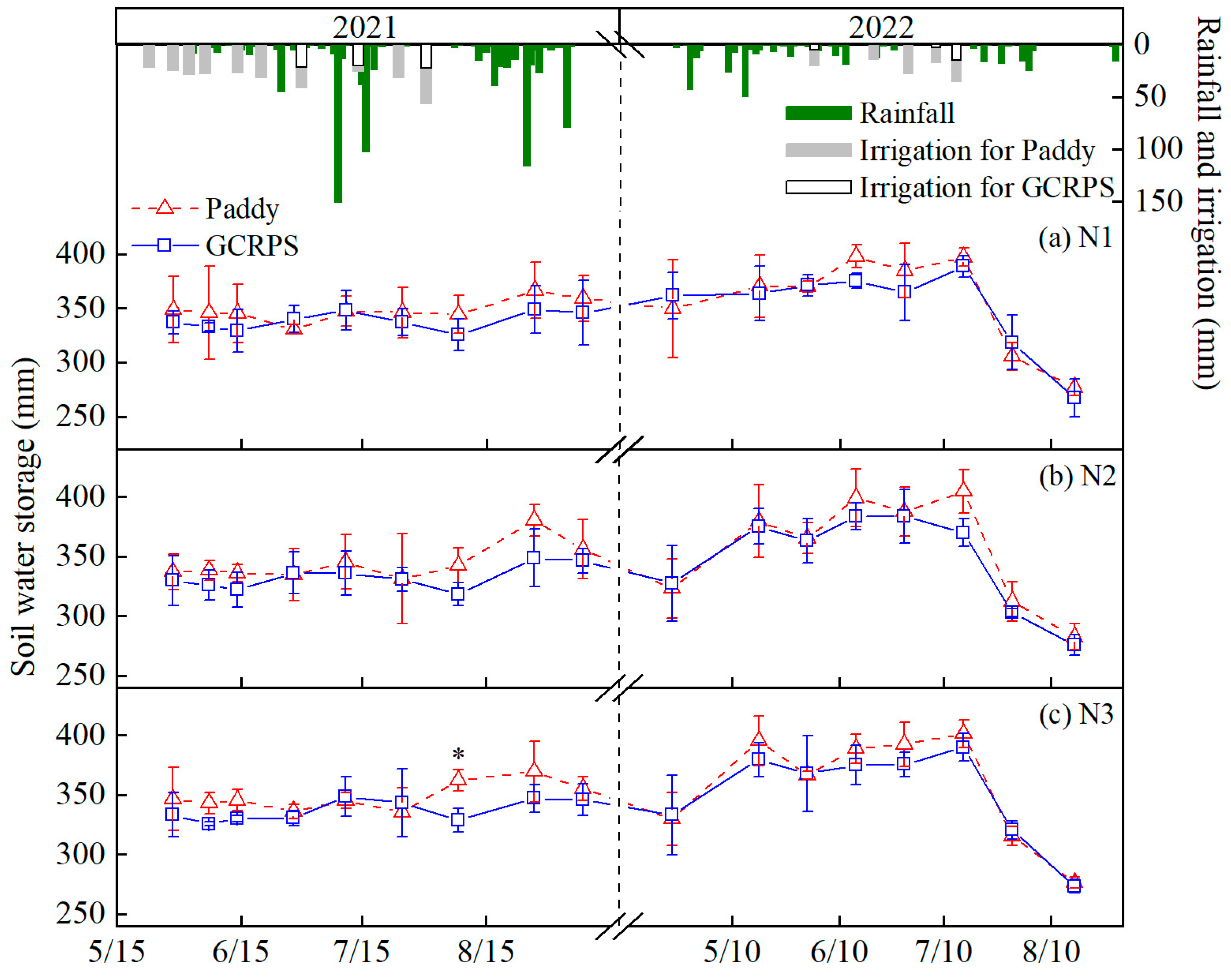
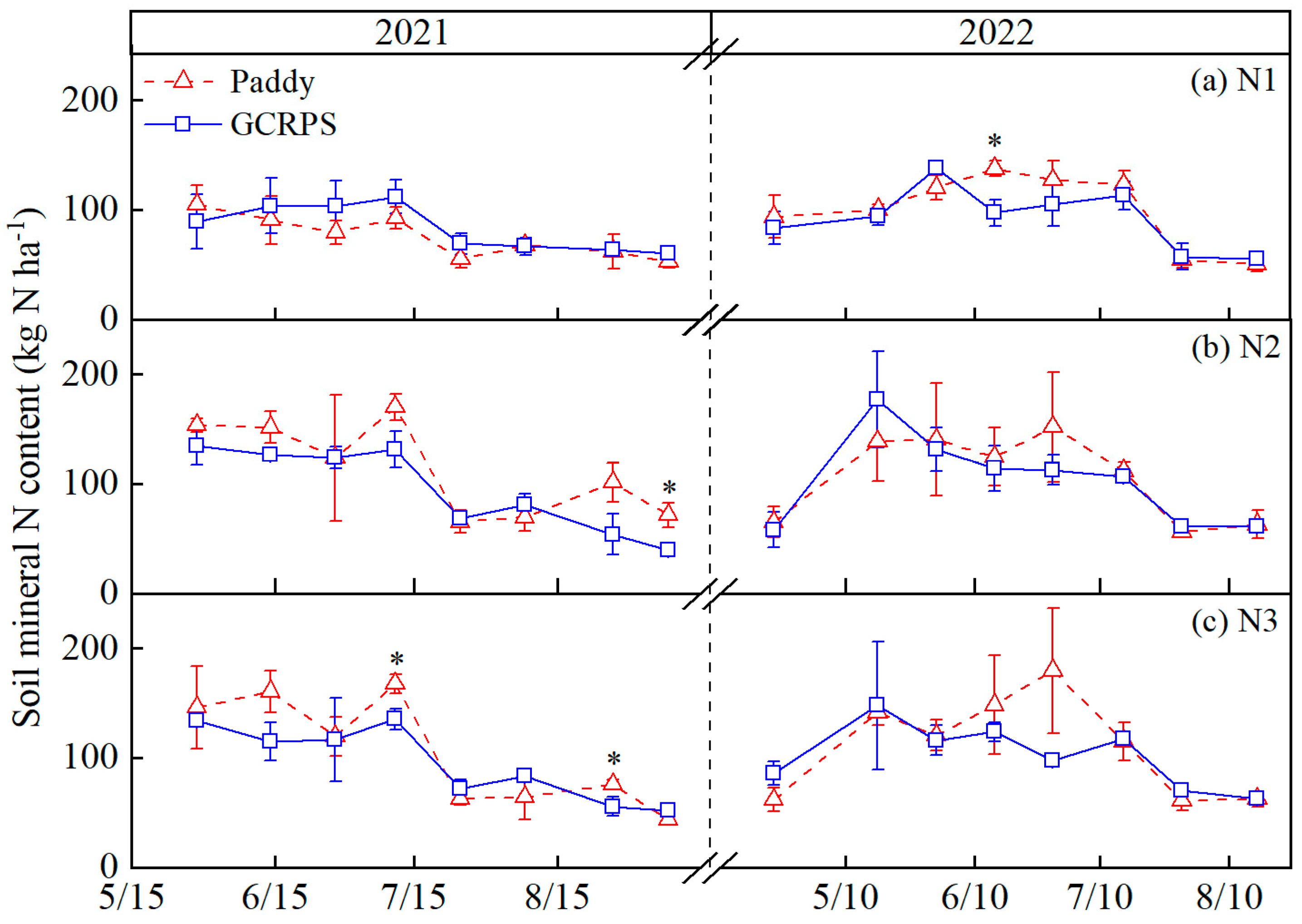
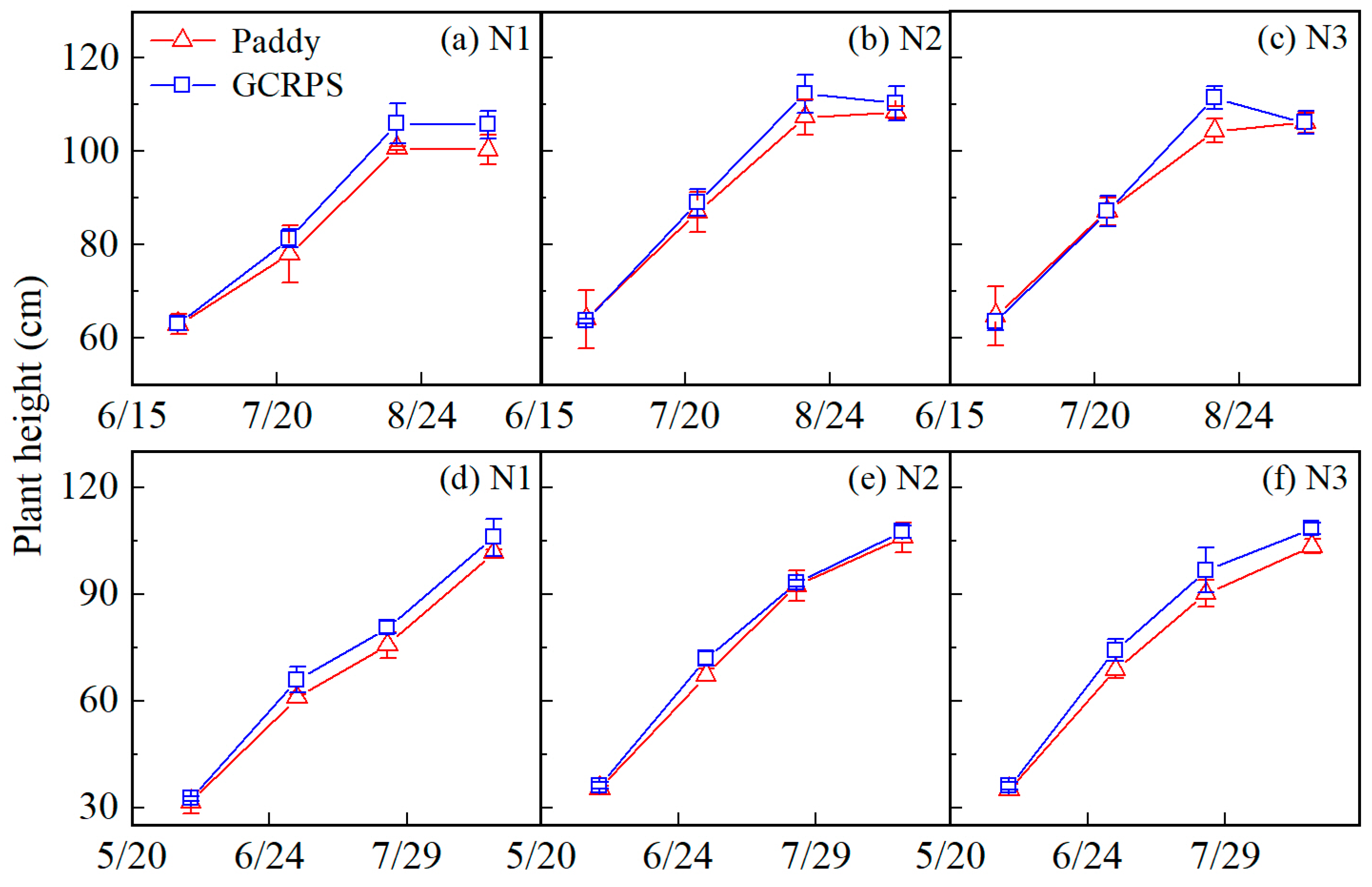
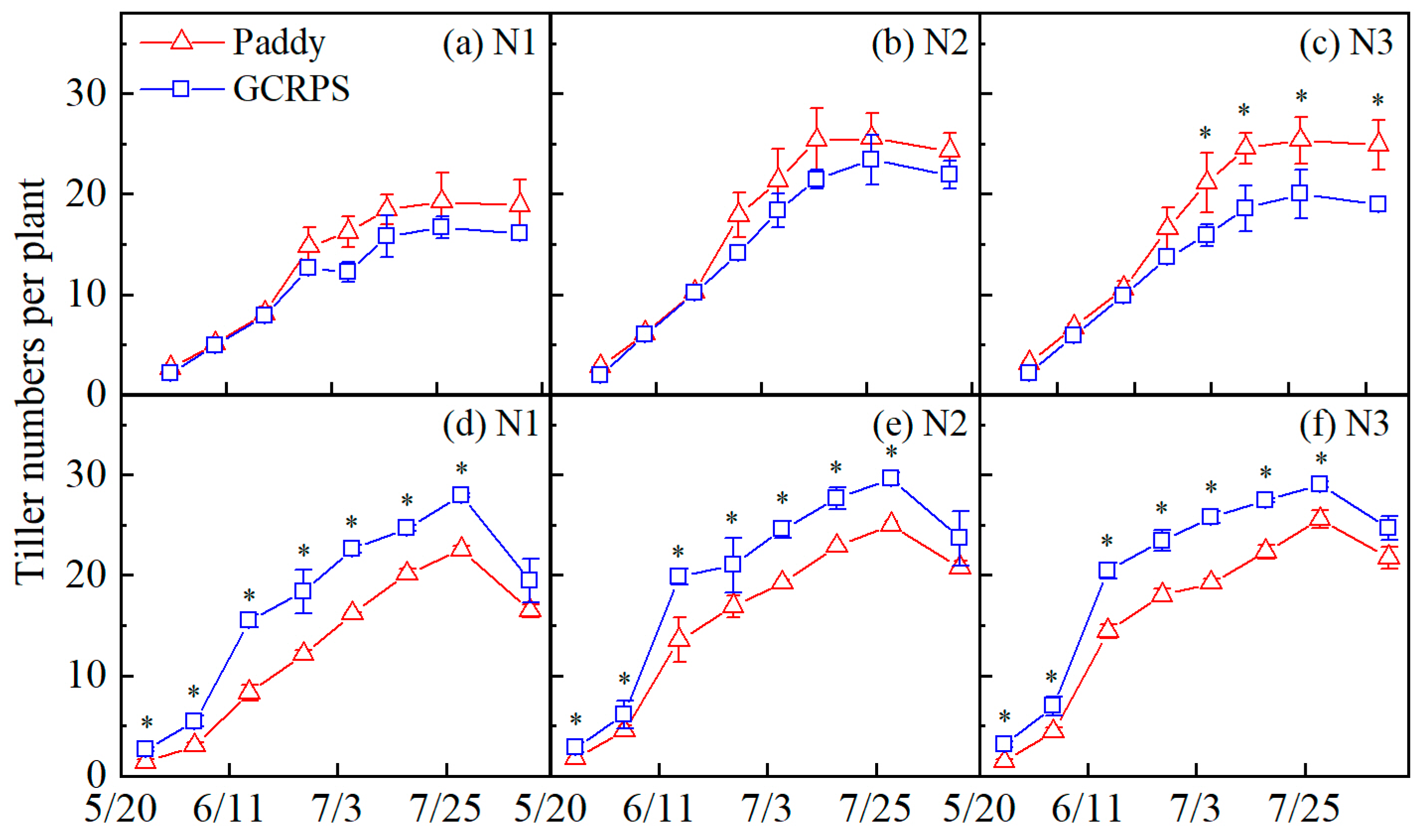
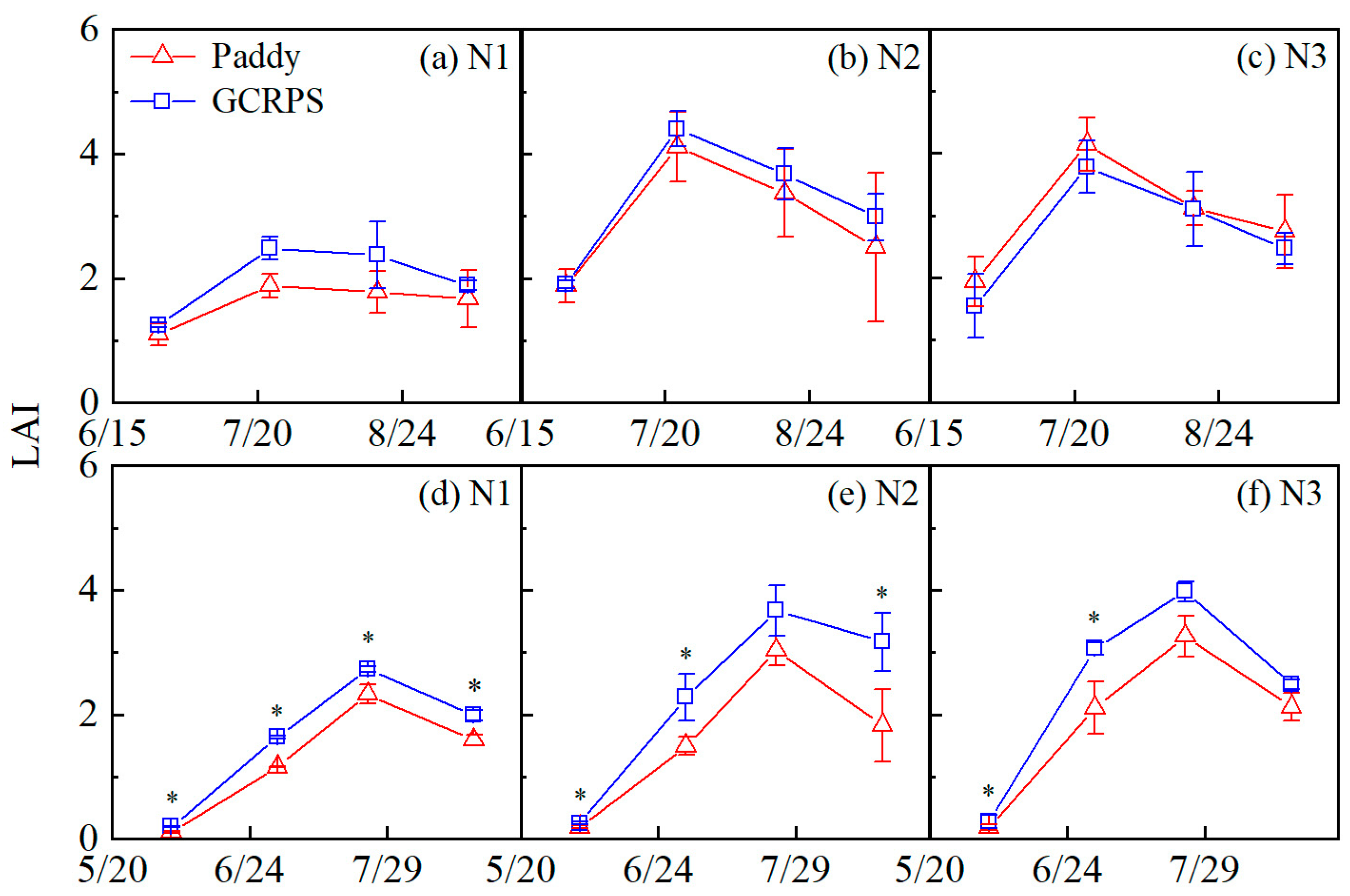
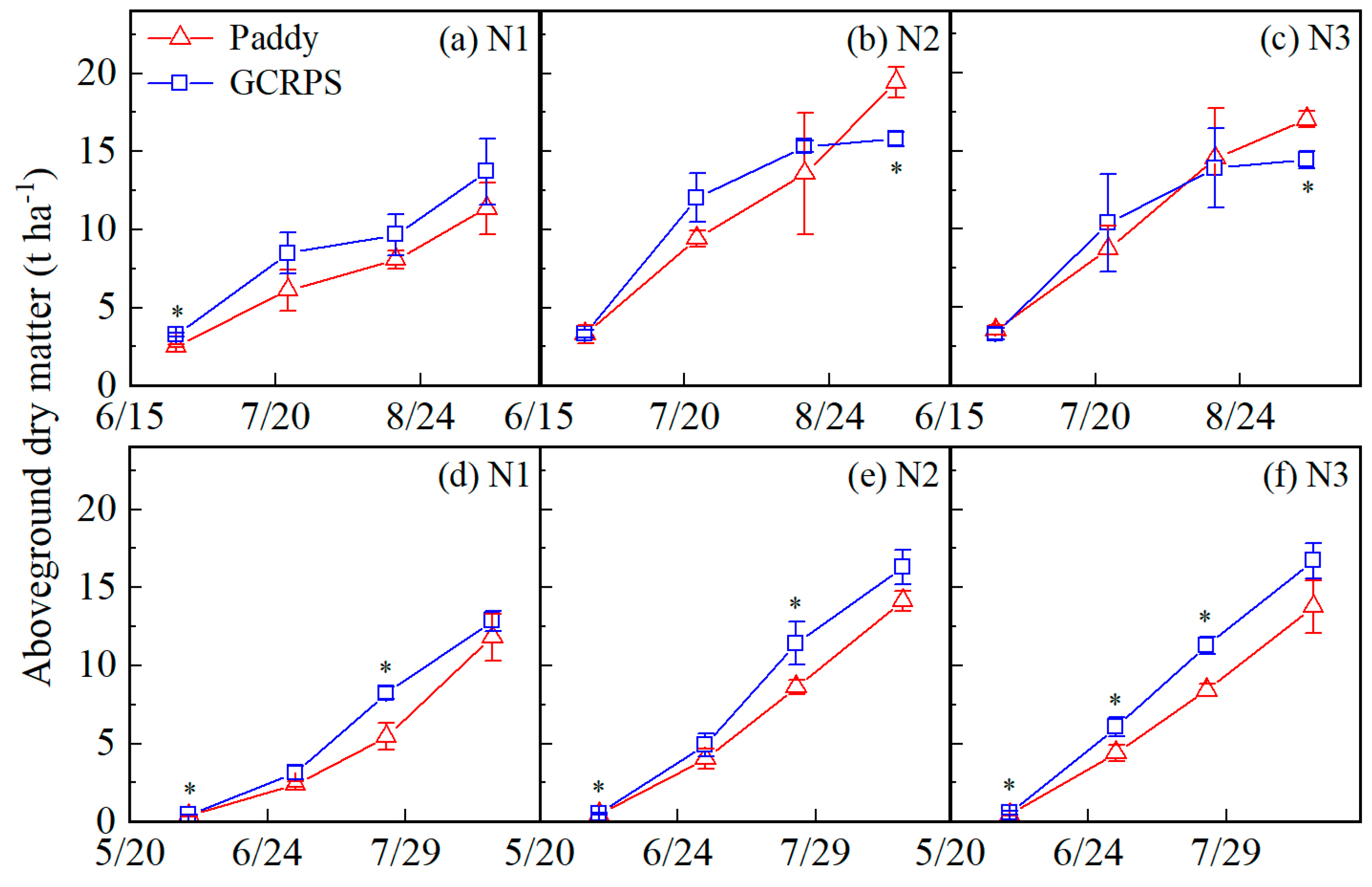

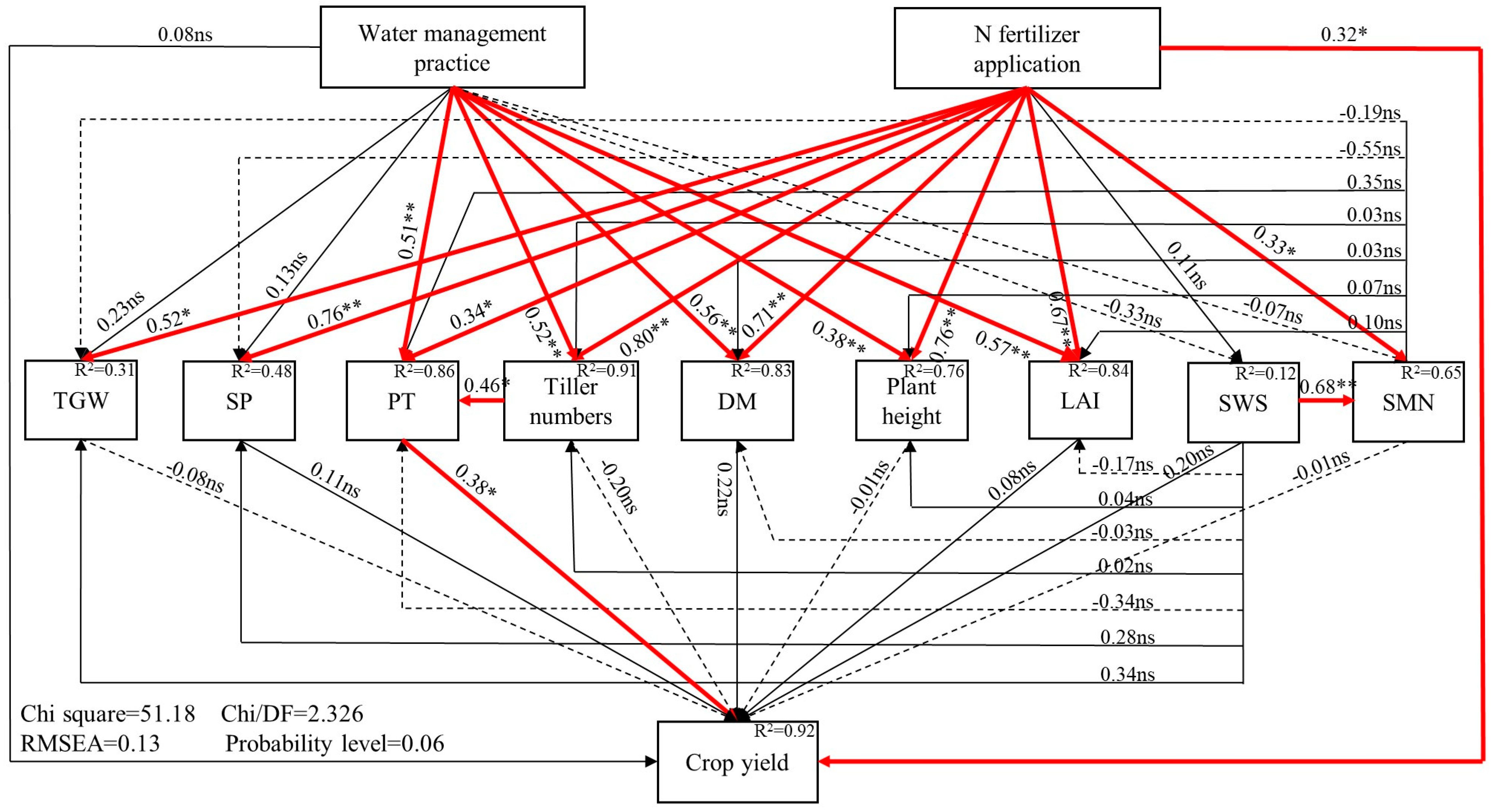
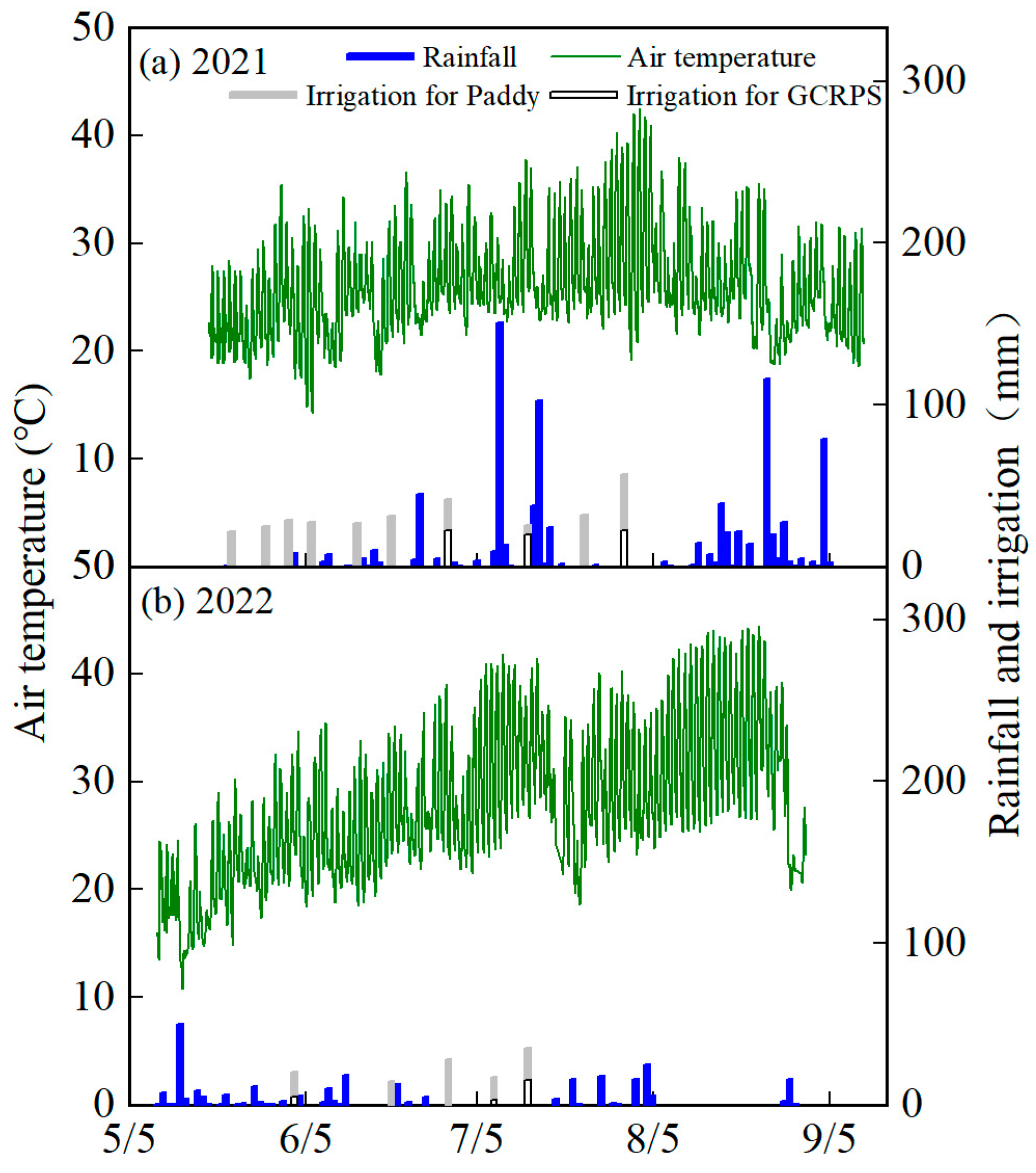
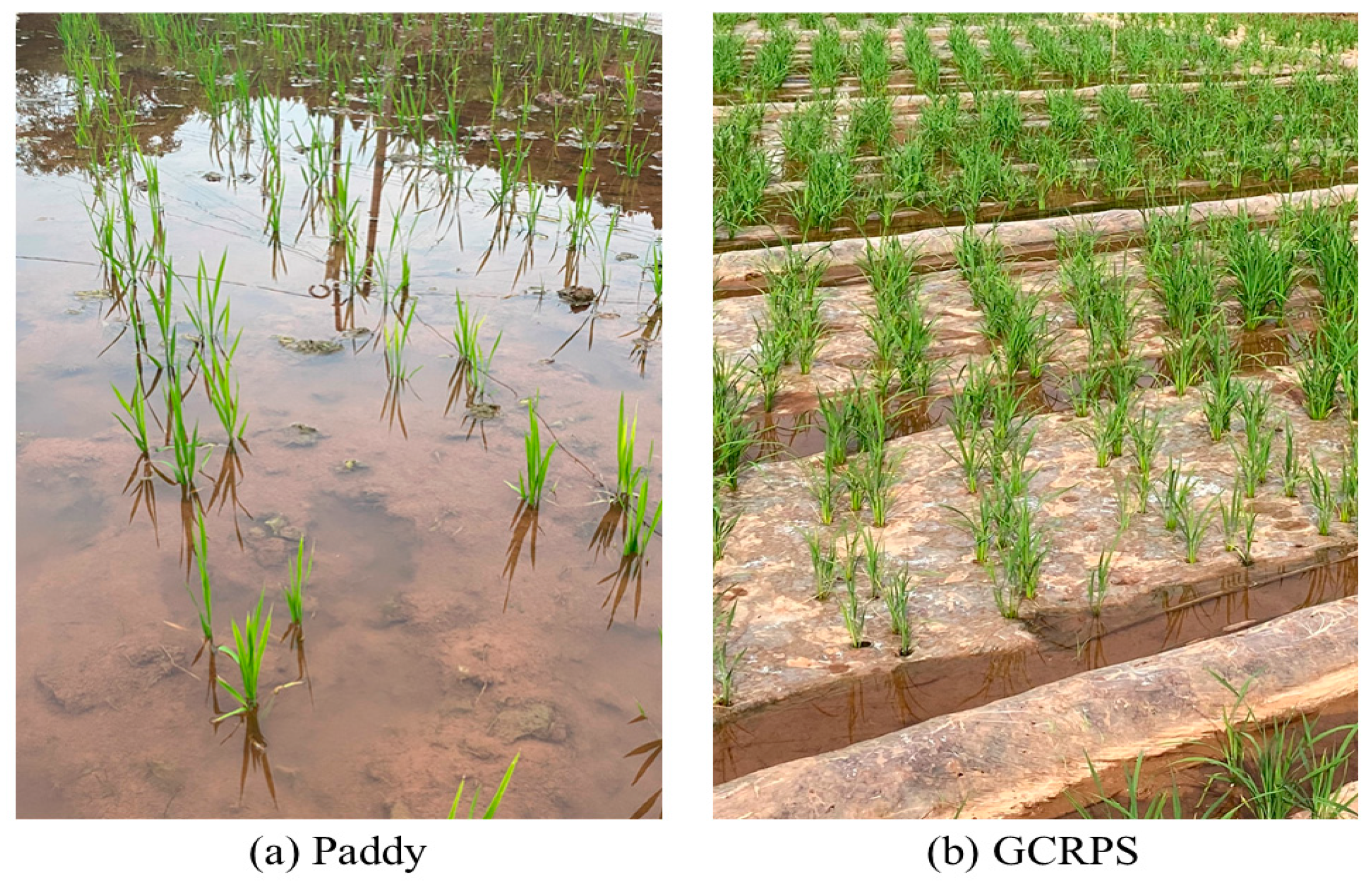
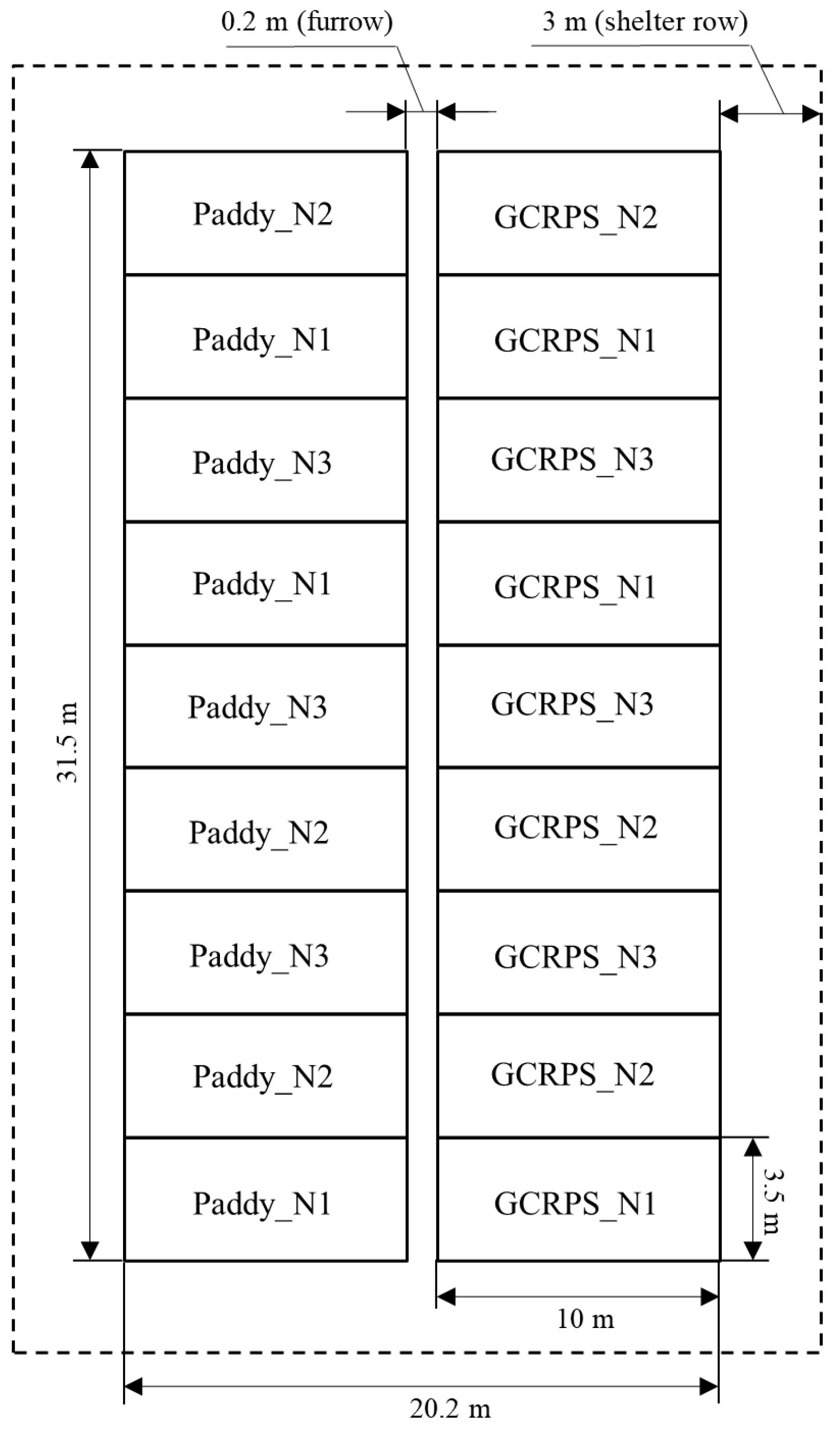
| Source | W | N | Y | W × N | W × Y | Y × N | W × N × Y |
|---|---|---|---|---|---|---|---|
| DF | 1 | 2 | 1 | 2 | 1 | 2 | 2 |
| F value | 8.6 ** | 82.3 *** | 2.0 ns | 3.0 ns | 26.2 ** | 15.7 ** | 1.3 ns |
| Treatment | 2021 | 2022 |
|---|---|---|
| Paddy | 0.73 ns | 0.97 ** |
| GCRPS | 0.74 ns | 0.96 ** |
| pH | Particle Fraction (%) | Total N | SOC | NH4+−N | NO3−−N | AP | AK | ||||
|---|---|---|---|---|---|---|---|---|---|---|---|
| Sand | Silt | Clay | |||||||||
| 7.73 | 0.6 | 0.97 | 18 | 51 | 31 | 2.3 | 66.6 | 56.2 | 16.3 | 14.7 | 55 |
| Year | Paddy_N1 | Paddy_N2 | Paddy_N3 | GCRPS_N1 | GCRPS_N2 | GCRPS_N3 |
|---|---|---|---|---|---|---|
| 2021 | 335 | 316 | 298 | 65 | 65 | 65 |
| 2022 | 173 | 172 | 174 | 38 | 38 | 38 |
Disclaimer/Publisher’s Note: The statements, opinions and data contained in all publications are solely those of the individual author(s) and contributor(s) and not of MDPI and/or the editor(s). MDPI and/or the editor(s) disclaim responsibility for any injury to people or property resulting from any ideas, methods, instructions or products referred to in the content. |
© 2023 by the authors. Licensee MDPI, Basel, Switzerland. This article is an open access article distributed under the terms and conditions of the Creative Commons Attribution (CC BY) license (https://creativecommons.org/licenses/by/4.0/).
Share and Cite
Ren, J.; Feng, P.; Batchelor, W.D.; Hu, K.; Liu, H.; Lv, S. Ground Cover Rice Production System Affects Soil Water, Nitrogen Dynamics and Crop Growth Differentially with or without Climate Stress. Plants 2023, 12, 3866. https://doi.org/10.3390/plants12223866
Ren J, Feng P, Batchelor WD, Hu K, Liu H, Lv S. Ground Cover Rice Production System Affects Soil Water, Nitrogen Dynamics and Crop Growth Differentially with or without Climate Stress. Plants. 2023; 12(22):3866. https://doi.org/10.3390/plants12223866
Chicago/Turabian StyleRen, Jian, Puyu Feng, William D. Batchelor, Kelin Hu, Haitao Liu, and Shihua Lv. 2023. "Ground Cover Rice Production System Affects Soil Water, Nitrogen Dynamics and Crop Growth Differentially with or without Climate Stress" Plants 12, no. 22: 3866. https://doi.org/10.3390/plants12223866
APA StyleRen, J., Feng, P., Batchelor, W. D., Hu, K., Liu, H., & Lv, S. (2023). Ground Cover Rice Production System Affects Soil Water, Nitrogen Dynamics and Crop Growth Differentially with or without Climate Stress. Plants, 12(22), 3866. https://doi.org/10.3390/plants12223866







